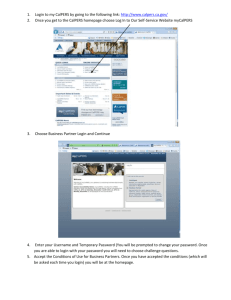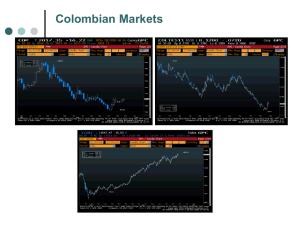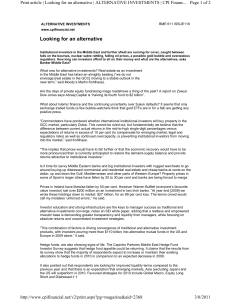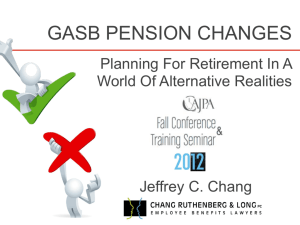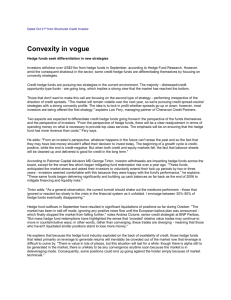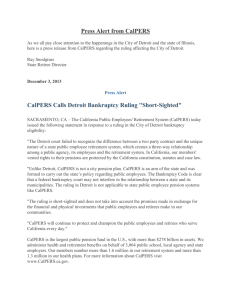C Memorandum
advertisement
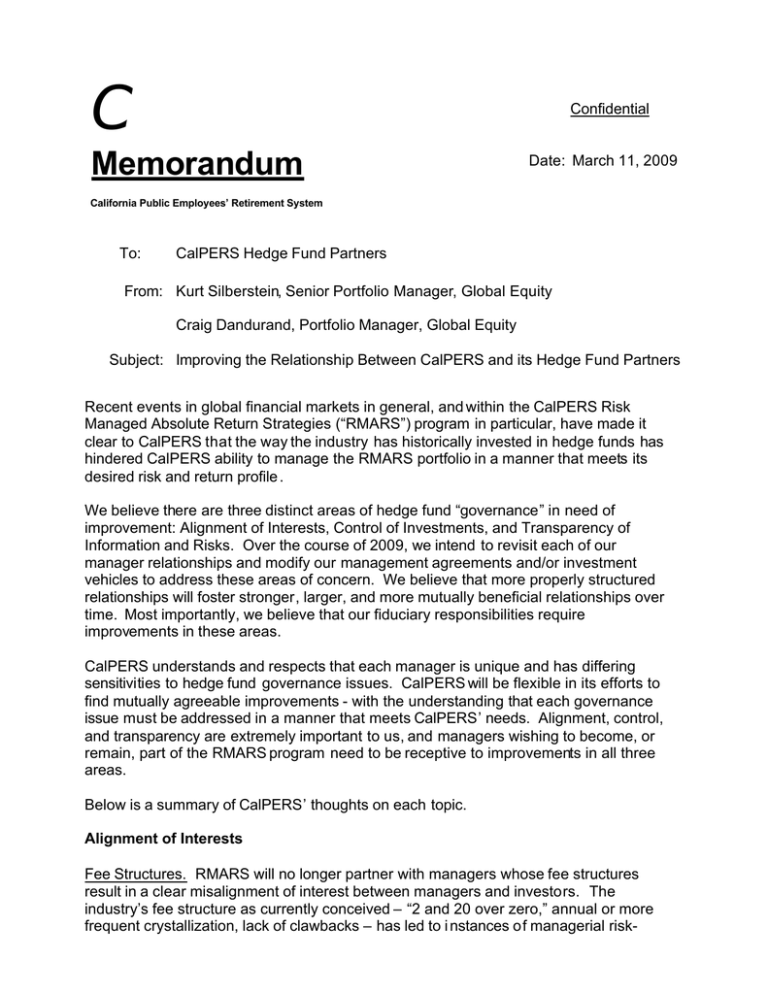
C Memorandum Confidential Date: March 11, 2009 California Public Employees’ Retirement System To: CalPERS Hedge Fund Partners From: Kurt Silberstein, Senior Portfolio Manager, Global Equity Craig Dandurand, Portfolio Manager, Global Equity Subject: Improving the Relationship Between CalPERS and its Hedge Fund Partners Recent events in global financial markets in general, and within the CalPERS Risk Managed Absolute Return Strategies (“RMARS”) program in particular, have made it clear to CalPERS that the way the industry has historically invested in hedge funds has hindered CalPERS ability to manage the RMARS portfolio in a manner that meets its desired risk and return profile . We believe there are three distinct areas of hedge fund “governance” in need of improvement: Alignment of Interests, Control of Investments, and Transparency of Information and Risks. Over the course of 2009, we intend to revisit each of our manager relationships and modify our management agreements and/or investment vehicles to address these areas of concern. We believe that more properly structured relationships will foster stronger, larger, and more mutually beneficial relationships over time. Most importantly, we believe that our fiduciary responsibilities require improvements in these areas. CalPERS understands and respects that each manager is unique and has differing sensitivities to hedge fund governance issues. CalPERS will be flexible in its efforts to find mutually agreeable improvements - with the understanding that each governance issue must be addressed in a manner that meets CalPERS’ needs. Alignment, control, and transparency are extremely important to us, and managers wishing to become, or remain, part of the RMARS program need to be receptive to improvements in all three areas. Below is a summary of CalPERS’ thoughts on each topic. Alignment of Interests Fee Structures. RMARS will no longer partner with managers whose fee structures result in a clear misalignment of interest between managers and investors. The industry’s fee structure as currently conceived – “2 and 20 over zero,” annual or more frequent crystallization, lack of clawbacks – has led to i nstances of managerial risk- Memo to RMARS Managers March 2, 2009 Page 2 of 5 taking which have been detrimental to the alignment principle and contrary to CalPERS’ concept of a long-term investor-manager relationship. Managers should institute a fee structure (both management and performance) based on the fund’s strategy, the size of an investor’s allocation to a fund, and the size of both fund and firm. Management fees should be designed to sustain the business without encouraging asset gathering at the expense of returns. Managers of funds without hurdle rates (cash or otherwise) will need to provide a valid explanation for maintaining a fee structure which calls for a “performance fee” to be paid even when a fund returns more than zero but less than cash. Crystallization of Performance Fees. Arrangements which call for annual (or, worse, quarterly) crystallization of performance fees greatly skew a manager’s incentives toward short-term gains at the expense of a long-term relationship – even when the manager claims to be (or truly is) a “long-term” investor. These arrangements are particularly displeasing when a manager has realized tens of millions of dollars in performance fees and then suffers a sizable loss, resulting in a minimal capital gain or a net capital loss for the investor - but a large profit for the manager - at the end of the so-called “partnership”. RMARS will no longer invest with managers who require such terms. Managers in the RMARS program will no longer be permitted to crystallize all accrued performance fees prior to the conclusion of RMARS’s relationship with the manager. RMARS is comfortable with partial crystallizations of performance fees as appropriate for a fund’s strategy, liquidity, time horizon for realization of gains or losses, and risk parameters. One example may call for a fund’s performance fee for a given year to crystallize 25% per year at the end of that year and the next two years, with the remainder held until redemption and all uncrystallized amounts being held in accrual and subject to clawback. Managers should not expect to crystallize performance fees accruing from profits earned on RMARS capital still subject to lockup with the possible exception of meeting tax liabilities. If this format encourages managers to truncate investment programs (and accelerate crystallization) in the face of potential future difficulty for a manager’s strategy, the avoidance of losses clearly benefits both manager and investor and, if properly executed, will certainly be viewed favorably in the context of building a long-term relationship. Business Management. Managers should be able to explain and demonstrate how the firm will retain talent in the event of a difficult year for the manager’s funds or strategies. Hedge fund managers are expected to exhibit the same sound approach to business management they expect from the companies in which they invest. Anything less adds an unquantifiable and unacceptable level of risk to our investment. Memo to RMARS Managers March 2, 2009 Page 3 of 5 Going forward, managers should expect to discuss and provide the following: (1) Evidence that their fund’s management and performance fee structures (including hurdle rates or the lack thereof) are appropriate given the fund’s strategy, investment universe, time horizon, and operating structure. (2) A common-sense proposal for ensuring that crystallization of performance fees strikes a proper balance between short-term and long-term goals for both investor and manager. (3) A proactive effort to enhance alignment of interests between investor and manager, both in terms of the investment vehicle and in terms of the manager’s business operations. Control of Investments Most hedge fund managers commingle assets from a variety of investors who themselves ha ve disparate risk and return expectations, as well as widely varying liquidity profiles. As a result, investors who would otherwise be willing to “ride out” what may be temporary price dislocations believe they are forced to redeem in order to avoid being left “holding the bag” should other investors precede them out the exit door. This turns hedge fund investing from a matter of assessing investment, strategy, and manager-related risks to a matter of “game theory” – a game that rarely benefits investors or managers. The RMARS program’s investments in funds of hedge funds (FoHFs) have been designed as customized portfolios which give us “control of our own destiny.” We believe this approach has been of benefit to us as many of our FoHFs have performed relatively well in a difficult environment and without investor-driven liquidity concerns. We believe that “control of our own destiny” is a concept that needs to be applied to our direct hedge fund relationships as well. Control will in many instances mean separate or managed accounts. In far too many instances a hedge fund’s operative documents provide too much flexibility to managers – in terms of investment type, time horizon, and ability to gate or suspend redemptions, among other things. In other (rarer) instances, the fund’s documents are too narrow – providing liquidity at the wrong frequency, perhaps, or not allowing for a gate when one is appropriate. RMARS will look to minimize these risks by entering into account relationships that are properly tailored to a manager’s strategy and investment approach. Done properly, these relationships will give RMARS sufficient flexibility to render its own determination of the continued viability of the investment vehicle on an ongoing basis. There is, after all, no need to concern oneself with gates or suspensions when there is only one investor in a fund. Memo to RMARS Managers March 2, 2009 Page 4 of 5 This is not to say RMARS wishes to tie a manager’s hands with respect to capitalizing on the full range of opportunities available to it – quite the contrary. When a fund must focus on raising cash for the next redemption period it cannot focus on maximizing riskadjusted returns. When a manager maintains a meaningful dialogue with its investors, game theory is replaced by partnership, and short-term liquidity scrambles are replaced by long-term benefits for manager and investor alike. Stronger relationships offer a better environment for larger allocations as well as more nimble ones – taking advantage of opportunities that require rapid response, for example, or modifying a fund’s risk profile in light of changing markets. Transparency of Information and Risks Another key element of hedge fund governance is the transparency of a fund’s investments and risks. RMARS will no longer invest in managers who do not provide full security-level transparency. We will expect to have this information on a more or less contemporaneous basis. There will be two primary methods of providing RMARS the transparency we require: (1) A managed account or separate account over which CalPERS maintains control and/or custody of the investments. (2) Complete transparency provided to CalPERS through channels to be determined (e.g., prime broker feeds, risk aggregators like IFS, etc.) In most instances, RMARS is ready, willing, and able to enter into non-disclosure agreements to ensure the privacy and security of this information, and in most instances California state law provides additional protection in this regard. If these protections are insufficient to provide a hedge fund manager with an acceptable degree of comfort, then both parties will be best served by seeking other partners. Examples of Approaches We want to make abundantly clear that we believe there is no “right” or “wrong” way to structure a relationship between manager and investor. We will gladly consider a variety of approaches to tackling the alignment, control, and transparency issues discussed above. Some possible approaches might include: • Management and/or performance fees which decline as assets grow, either within a separate/managed account or across a commingled account. • The imposition of cash-type hurdle rates or a lower performance fee over a zero hurdle. Memo to RMARS Managers March 2, 2009 Page 5 of 5 • Performance fees which fluctua te depending on the level of gross returns: e.g., X% of the first 10% of gross returns, Y% of the next 10% of gross returns, Z% of gross returns above 20%. • A structure where performance fees “vest” and are crystallized fractionally over a set number of years. • A rolling performance fee structure, perhaps over three or four years. • A requirement that managers reinvest a given percentage of performance fees in the fund. • Separate/managed account provisions allowing for the investor or the manager to terminate the other on fairly short notice, thus bolstering the control element for both parties. • Mutually agreed constraints on investment type, existing and expected liquidity, time horizon, geography, etc., to better capitalize on a manager’s unique skillset. • A “business financial continuity plan” setting forth means by which financial reserves will be tapped to ensure retention of talent in difficult environments. We are encouraged by the discussions we have already had with many of you about these issues, and we look forward to following up with each of our RMARS program managers in the near future. Our hope is that hedge fund managers who are proactive in addressing these issues will benefit in the short term by showing leadership among their peers. More importantly, over the longer term we believe managers engaging in better governance will find themselves attracting a stronger client base and in turn developing more profitable and sustainable businesses. Please contact us with any questions and concerns you may have. cc: ARS Advisory Board Jane Buchan, PAAMCO Bill Brown, UBS AIS Marte Castanos, CalPERS Counsel Jedd Wider, Morgan Lewis
